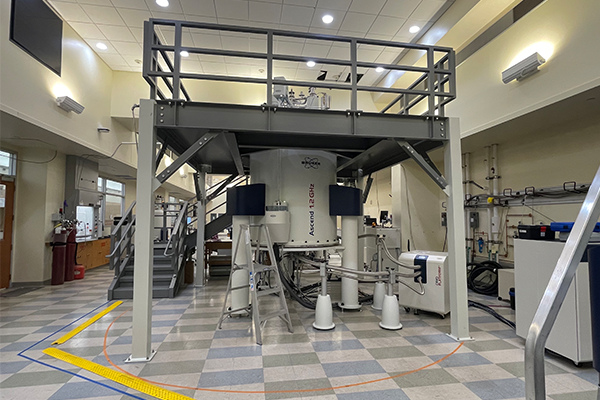First 1.2 GHz NMR Spectrometer in the United States at The Ohio State University funded by the U.S. National Science Foundation

Novel GHz-class NMR systems are enabling novel life science and materials research in functional structural biology, drug discovery, metabolomics and cleantech research.
A 1.2 Gigahertz (GHz) NMR system at the National Gateway Ultrahigh Field NMR Center (https://gateway-nmr.osu.edu/) at The Ohio State University has been successfully installed by Bruker Corporation as the first such scientific instrument in the United States.
Ultra-high field NMR is highly differentiated and complementary to other technologies. In structural biology it provides unique capabilities to observe functional dynamics and protein-protein, protein-RNA or protein-drug interactions close to native conditions in solution or in cell membranes. NMR also has pioneered the ability to elucidate ‘hidden’, short-lived protein states important in both healthy and disease biology, e.g., in active enzymes or in the onset of protein aggregation in neurodegenerative diseases. Many key proteins in cell biology, including proteins implicated in cancer, infectious disease or neurodegeneration, are intrinsically fully or partially disordered, with GHz-class NMR enabling pivotal research of structural disorder in pathobiology.
The U.S. National Science Foundation (NSF) has played a crucial role in the US in funding the 1.2 GHz NMR instrument at The Ohio State University. Dr. Robert Fleischmann, who is the NSF program officer of the grant that funded the 1.2 GHz NMR instrument (NSF Award 1935913), considers this instrument an important advancement of the scientific infrastructure in the United States. "Supported by one of the first awards made by NSF’s Directorate for Biological Sciences as part of the agency’s Midscale Research Infrastructure program, the 1.2 GHz NMR will fulfill a national need and enable U.S. researchers to be competitive in a global research environment and advance the U.S. bioeconomy. It’s a prime example of the type of infrastructure the program was designed to support – the critical tools and technology that fall between major research instrumentation and large facilities.”
The 1.2 GHz NMR spectrometer is a state-of-the-art instrument that enables high-resolution liquid and solid-state NMR experiments. It will be used by researchers at Ohio State and across the U.S. to study advanced materials, e.g., for batteries, and the structure and dynamics of biological molecules, with the goal of advancing the understanding of the underlying mechanisms of diseases, such as cancer, viral infections or Alzheimer’s.
Dr. Rafael Brüschweiler, a professor of chemistry and biochemistry at The Ohio State University, and PI of the National Gateway Ultrahigh Field NMR Center, is a leading expert in NMR. His cross-disciplinary research has been instrumental in the development of new techniques to understand the role of protein dynamics and interactions, as well as to analyze complex biological mixtures in metabolomics. He stated: "The installation of the 1.2 GHz NMR instrument will give us the capability to explore the structure and dynamics of biological molecules at an unprecedented level of detail. This breakthrough will allow us to make significant advances in our understanding of how these molecules function, ultimately leading to the development of new treatments for diseases. We are excited about the possibilities that lie ahead and look forward to the discoveries that this new technology will enable."
Dr. Falko Busse, President of Bruker BioSpin, described the installation of the Ohio State 1.2 GHz NMR instrument as a milestone, and said: “We are honored to have the opportunity to work with The Ohio State University to bring this groundbreaking technology to the United States. GHz-class NMR represents a leap forward in the ability to study the structure and function of biological molecules. It is great to see ultrahigh-field NMR gain traction in the United States, and elsewhere. In addition to the 1.2 GHz installation at Ohio State, Bruker’s engineers have successfully installed a 1.1 GHz NMR at St. Jude Children’s Research Hospital and at the University of Wisconsin-Madison. We look forward to seeing the impact our instruments will have on leading-edge life science and materials research in the US.”
The Ohio State University has the first 1.2 GHz NMR in the United States, a milestone in the advancement of US life science and materials research infrastructure, with leadership and funding by the National Science Foundation. In Europe, eight 1.2 GHz NMRs are installed, with four more on order, and one is on order in South Korea.
